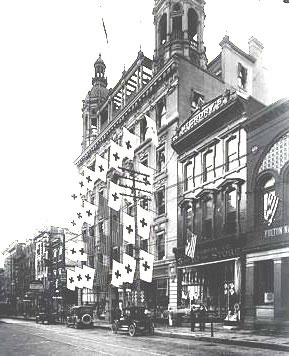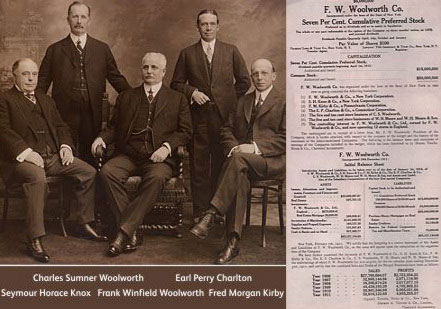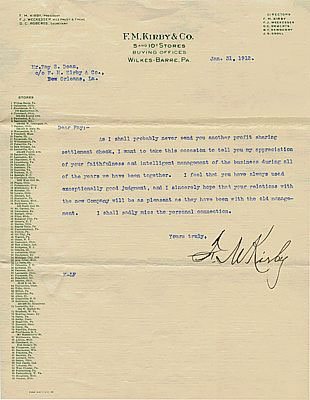The $65 million merger

From the late 19th century until 1912 Frank Woolworth headed a consortium of friendly rival dime store companies, each trading under its Founder's name. Most of the proprietors were either relatives or former work colleagues. William Moore had been Frank's boss and is credited with setting up the first five cent table in his Watertown Dry Goods Store and bankrolling Frank's first stores. Fred Kirby was a co-worker in Watertown, while Seymour Knox was Frank's cousin and Charles Sumner Woolworth was his younger brother. Only Earle Charlton had joined from the outside.
The larger chains incorporated between 1905 and 1908, selling shares to Managers and friends. The idea was a money-spinner which also afforded some protection against a hostile takeover. Meanwhile new entrants were copying the formula, opening rival five-and-tens next door to Syndicate branches.
 Woolworth used to tell his Managers that the best store to have next door was a rival 5 & 10¢, because this would demonstrate his superior value and better range of products. But he had to invest heavily to beat off the competition. He bought special lines for $1 and placed them on sale for 10¢ at the weekend as a spoiling tactic. On one occasion the windows of the store in Lancaster (right) were changed five times in a single night until his competitors went to bed!
Woolworth used to tell his Managers that the best store to have next door was a rival 5 & 10¢, because this would demonstrate his superior value and better range of products. But he had to invest heavily to beat off the competition. He bought special lines for $1 and placed them on sale for 10¢ at the weekend as a spoiling tactic. On one occasion the windows of the store in Lancaster (right) were changed five times in a single night until his competitors went to bed!
McCrory, Kresge, N.M. Rothschild and J.J. Newberry were threats that merited special attention. Their activities were closely monitored, with Syndicate Members devising schemes to confound them.
In 1911 Frank Woolworth proposed a more radical solution. If the Friendly Rivals were to merge, it would create a super-company that would be much larger than any competitor. Its size would protect it from hostile takeover, and, as an added bonus, by selling shares on the stock market, it would help each of the Founders to capitalise on their hard work. They could decide how many shares to sell and how many to keep.
Syndicate members had reservations, particularly when Woolworth insisted that only his name would appear on the masthead of the new company, but Frank continued to push the idea.

He won the dissenters around after their brokers assessed the potential value of the merged company. As a concession Woolworth agreed to drop the ampersand ("&") from the name.
It was agreed that the new F.W. Woolworth Co. would take control on 31 January 1912. Over the next decade, as stores fell due for repainting, the fascias were updated to the new name. The only exception was the British subsidiary, which retained its original name, F. W. Woolworth & Co. Ltd.
Frank Woolworth was wise to fight to put his name on the masthead. Today his is the name that is mainly remembered. In some ways it seems sad that few people have heard of Charles Sumner Woolworth, who served the company for 68 years, and led it as Chairman for 29 years, or Fred Moore Woolworth who founded and shaped the British operation. Each of the original pioneers is remembered in his home town as a result of charitable bequests and endowments, but their contribution to modern retailing has largely been forgotten.
By way of an epilogue to the story, on the eve of the $65m merger on 31 January, 1912, Fred Morgan Kirby wrote to a member of his staff to express his mixed feelings of sadness and hope for the future. His letter concludes "I sincerely hope that your relations with the new Company will be as pleasant as they have been with the old management. I shall sadly miss the personal connection."
Each Founder's name was retained on just one fascia, at their former chief store. Sadly even those have now disappeared after the US business faded into retirement.
The $65m merger brought great riches to each of the Founders. Each man gave generously during his lifetime and left a sizeable portion of his estate to good causes. The charitable trusts, scholarships, foundations, art centres and hospitals that carry their names continue to do much good work in the twenty-first century.
Shortcuts to related content




